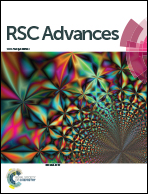1H and 195Pt NMR prediction for inclusion compounds formed by cisplatin and oxidized carbon nanostructures†
Abstract
Prediction of NMR chemical shifts can assist experimentalists in the characterization of drug delivery systems based on carbon nanocomposites. Chemical shifts are strongly correlated to the nucleus position and its chemical neighborhood. Therefore, to predict structures and NMR properties of complex chemical models, choosing a more consistent theoretical level capable of providing more realistic results and moderate computational demand is a major challenge. In this work, we predicted the NMR spectra of inclusion compounds formed by cisplatin (cDDP) and an oxidized carbon nanotube (CNTox) and nanocone (CNCox) considered by specialists as potential drug delivery systems. The 195Pt NMR chemical shifts calculated at the DFT level with the new relativistic NMR-DKH basis set were −2314 ppm and −2192 ppm for cDDP@CNTox and cDDP@CNCox complexes, respectively, which are both high-field shifted relative to the free cDDP (−2110 ppm). 1H NMR chemical shifts are also sensitive to the inclusion process. The H (NH3) signals are found on average at +4.3 (cDDP), −5.1 (cDDP@CNTox) and +6.6 ppm (cDDP@CNCox). Interestingly, despite the similar inclusion modes in CNTox and CNCox cavities, the 1H NMR shifts were in opposite directions. A possible reason might be the higher stability of cDDP@CNTox (ΔEF = −19.9 kcal mol−1) than that of cDDP@CNCox (ΔEF = −5.7 kcal mol−1), which suggests a short guest–host contact in the former and consequently, a more efficient shielding of hydrogen atoms due to the electron-rich carbon structure. These results may be helpful as comparison data in the NMR spectra assignment in solution and the inclusion compounds' structural elucidation.



 Please wait while we load your content...
Please wait while we load your content...